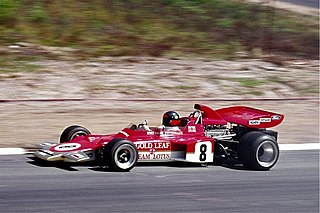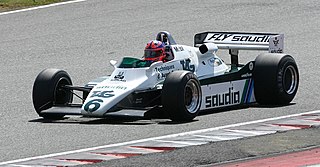Brabham is the common name for Motor Racing Developments Ltd., a British racing car manufacturer and Formula One racing team. Founded in 1960 by Australian driver Jack Brabham and British-Australian designer Ron Tauranac, the team won four Drivers' and two Constructors' World Championships in its 30-year Formula One history. Jack Brabham's 1966 FIA Drivers' Championship remains the only such achievement using a car bearing the driver's own name.
Williams Grand Prix Engineering Limited, currently racing in Formula One as Williams Racing, is a British Formula One team and constructor. It was founded by Frank Williams and Patrick Head. The team was formed in 1977 after Frank Williams' earlier unsuccessful F1 operation: Frank Williams Racing Cars.

The DFV is an internal combustion engine that was originally produced by Cosworth for Formula One motor racing. The name is an abbreviation of Double Four Valve, the engine being a V8 development of the earlier four-cylinder FVA, which had four valves per cylinder.

The 1980 Austrian Grand Prix was a Formula One motor race held on 17 August 1980 at the Österreichring circuit in Austria. It was the tenth race of the 1980 Formula One season. The race was the 13th Austrian Grand Prix and the eleventh to be held at the Österreichring. The race was held over 54 laps of the 5.942-kilometre circuit for a total race distance of 321 kilometres.
The 1980 Canadian Grand Prix was a Formula One motor race held on 28 September 1980, at the Circuit Île Notre-Dame in Montreal, Quebec, Canada. It was the thirteenth and penultimate race of the 1980 Formula One season. The race was the 19th Canadian Grand Prix and the third to be held in Montreal. The race was held over 70 laps of the 4.41-kilometre circuit for a total race distance of 309 kilometres.

Hesketh Racing was a Formula One constructor from the United Kingdom, which competed from 1973 to 1978. The team competed in 52 World Championship Grands Prix, winning one and achieving eight further podium finishes. Its best placing in the World Constructors' Championship was fourth in 1975. Hesketh gave James Hunt his Formula One debut and he brought the team most of its success. Alan Jones also began his Formula One career in a privately entered Hesketh.
Vel's Parnelli Jones Racing, commonly referred to simply as Parnelli or VPJ, was a motor racing constructor and team from the United States. The team was formed in 1969 by former USAC racer Parnelli Jones and his business partner Velko "Vel" Miletich. Parnelli was initially solely concerned with USAC racing, where success came quickly; their driver Al Unser won the Indianapolis 500 race in 1970, driving a VPJ Colt, after leading 190 of the 200 racing laps. Unser went on to win the USAC championship. Unser repeated the Indy 500 win in 1971 with a new Colt built without the left side chassis offset that had been made illegal by 1971 rules, ending the season in fourth place in the USAC drivers points while teammate Joe Leonard won the championship.

Frank Williams Racing Cars was a British Formula One team and constructor.

The Lotus 79 is a Formula One car designed in late 1977 by Colin Chapman, Geoff Aldridge, Martin Ogilvie, Tony Rudd, Tony Southgate and Peter Wright of Lotus. The Lotus 79 was the first F1 car to take full advantage of ground effects aerodynamics.

The Lotus 72 is a Formula One car designed by Colin Chapman and Maurice Philippe of Lotus for the 1970 Formula One season. The 72 was a pioneering design featuring inboard brakes, side-mounted radiators in sidepods, and aerodynamic wings producing down-force.

The McLaren M23 was a Formula One racing car designed by Gordon Coppuck, with input from John Barnard, and built by the McLaren team. It was a development of the McLaren M16 Indianapolis 500 car. A Ford Cosworth DFV engine was used, which was prepared by specialist tuning company Nicholson-McLaren Engines. This helped push the DFV's horsepower output to around 490 bhp.

The Williams FW07 was a ground effect Formula One racing car designed by Patrick Head, Frank Dernie, and Neil Oatley for the 1979 F1 season.
Formula One sponsorship liveries have been used since the 1968 season, replacing national colours. Major sponsors such as BP, Shell, and Firestone had pulled out of the sport ahead of the season, prompting the Fédération Internationale de l'Automobile to allow unrestricted sponsorship. At the 1968 South African Grand Prix, South African privateer team Team Gunston became the first Formula One team to implement sponsorship brands as a livery when they entered a private Brabham car painted in the colours of Gunston cigarettes for John Love. In the next race, the 1968 Spanish Grand Prix, Team Lotus became the first works team to follow this example, with Graham Hill's Lotus 49B entered in the red, gold and white colors of Imperial Tobacco's Gold Leaf brand. With rising costs in Formula One, sponsors becoming more important and thus liveries reflected the teams' sponsors.

The Williams FW10 is a Formula One car designed by Frank Dernie for use by the Williams team in the 1985 Formula One World Championship. It was powered by a Honda RA165E V6 turbo engine and driven by Briton Nigel Mansell and Finn Keke Rosberg. An upgraded version of the car, dubbed the FW10B, was introduced late in the season, which enabled the team to win the final three races of the year.

The Lotus 102 was a Formula One racing car designed by Lotus for use in the 1990 Formula One season and would eventually go on to compete in 37 races spanning three seasons from 1990 until 1992.

The Williams FW09 was a Formula One car designed by Frank Dernie and Neil Oatley. It was the first Williams chassis to be powered by a turbocharged Honda V6 engine, for which Frank Williams negotiated a deal towards the end of 1982 and the beginning of 1983.

The McLaren M28 is a Formula One racing car built and run by McLaren in the 1979 Formula One World Championship. Powered by a naturally-aspirated Ford Cosworth 3-litre engine, the M28 was designed and wind tunnel tested during the latter half of 1978, at around the same time as Ronnie Peterson was mooted to join the team for the following season. The car was noticeably larger than contemporary designs and was much bulkier looking. Three chassis were built. The bulky design had a sharp impact on top speed, and the car was one of the slowest through speed traps. The car first appeared on track in October 1978 during a test at Watkins Glen.

The Williams FW08 was a Formula One car designed by Frank Dernie, which debuted at the 1982 Belgian Grand Prix held at the Zolder circuit. An evolution of the FW07 that it replaced, the car was used by Finnish driver Keke Rosberg to win the 1982 World Drivers' Championship.

The Williams FW was a Formula One car used by Frank Williams Racing Cars during the 1973, 1974 and 1975 seasons. It was designed by John Clarke.

The Williams FW04 was a Formula One car used by Frank Williams Racing Cars during the 1975 season and Wolf–Williams Racing during the 1976 season. The car was a development of the Williams FW and two were built. Although not a particularly successful car, an FW04 finished second at the 1975 German Grand Prix.

















